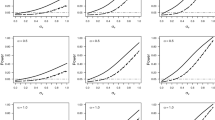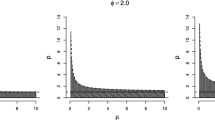Abstract
We model an overdispersed count as a dependent measurement, by means of the Negative Binomial distribution. We consider a quantitative covariate that is fixed by design. The expectation of the dependent variable is assumed to be a known function of a linear combination involving the possibly multidimensional covariate and its coefficients. In the NB1-parametrization of the Negative Binomial distribution, the variance is a linear function of the expectation, inflated by the dispersion parameter, and the distribution not a generalized linear model. For the maximum likelihood estimator for all parameters we apply a general result of Bradley and Gart (Biometrika 49:205–214, 1962) to derive weak consistency and asymptotic normality and a technique in Fahrmeir and Kaufmann (Ann Stat 13:342–368, 1985) for strong consistency. To this end, we show (1) how to bound the logarithmic density by a function that is linear in the outcome of the dependent variable, independently of the parameter. Furthermore (2) the positive definiteness of the matrix related to the Fisher information is shown with the Cauchy–Schwarz inequality.
Similar content being viewed by others
References
Amann H, Escher J (2005) Analysis I. Springer, Basel
Bauer H (2001) Measure and integration theory. De Gruyter, Berlin
Bickel PJ, Doksum KA (2007) Mathematical statistics: basic ideas and selected topics, 2nd edn. Pearson Prentice Hall, Upper Saddle River
Bradley RA, Gart JJ (1962) The asymptotic properties of ML estimators when sampling from associated populations. Biometrika 49:205–214
Cameron AC, Trivedi PK (2008) Regression analysis of count data, 7th edn. Cambridge University Press, Cambridge
Dobson AJ (2002) An introduction to generalized linear models, 2nd edn. Chapman, Boca Raton
Fahrmeir L, Kaufmann H (1985) Consistency and asymptotic normality of the maximum likelihood estimator in generalized linear models. Ann Stat 13:342–368
Feller W (1971) An introduction to probability theory and its applications, vol 2, 2nd edn. Wiley, New York
Gourieroux C, Monfort A (1995) Statistics and econometric models, vol 2. Cambridge University Press, Cambridge
Hilbe J (2011) Negative Binomial regression, 2nd edn. Cambridge University Press, Cambridge
Johnson NL, Kemp AW, Kotz S (2005) Univariate discrete distributions, 3rd edn. Wiley, Hoboken
Kremer A, Weißbach R, Liese F (2014) Maximum likelihood estimation for left-censored survival times in an additive hazard model. J Stat Plann Inference 149:33–45
Moore DF (1986) Asymptotic properties of moment estimators for overdispersed counts and proportions. Biometrika 73:583–588
Voß S, Weißbach R (2014) A score-test on measurement errors in rating transition times. J Econ 180:16–29
Wald A (1949) Note on the consistency of the maximum likelihood estimate. Ann Math Stat 20:595–601
Weißbach R, Walter R (2010) A likelihood ratio test for stationarity of rating transitions. J Econ 155:188–194
Weißbach R, Herzog M, Menzel G (2015) Regionaler Anteil kariesfreier Vorschulkinder—eine cluster-randomisierte Studie in Südhessen. AStA Wirtsch und Sozialstat Arch 9:27–39
Winkelmann R (2000) Econometric analysis of count data, 3rd edn. Springer, Berlin
Author information
Authors and Affiliations
Corresponding author
Ethics declarations
Conflict of interest
On behalf of all authors, the corresponding author states that there is no conflict of interest.
Additional information
Publisher's Note
Springer Nature remains neutral with regard to jurisdictional claims in published maps and institutional affiliations.
The financial support from the Deutsche Forschungsgemeinschaft (DFG) is gratefully acknowledged (Grant WE3573/3-1 “Multi-state, multi-time, multi-level analysis of health-related demographic events: Statistical aspects and applications” and CRC 823 “Statistical modelling of nonlinear dynamic processes”, Project A1: Dynamic Dependence Structures in Risky Asset Returns).
Rights and permissions
About this article
Cite this article
Weißbach, R., Radloff, L. Consistency for the negative binomial regression with fixed covariate. Metrika 83, 627–641 (2020). https://doi.org/10.1007/s00184-019-00750-5
Received:
Published:
Issue Date:
DOI: https://doi.org/10.1007/s00184-019-00750-5




